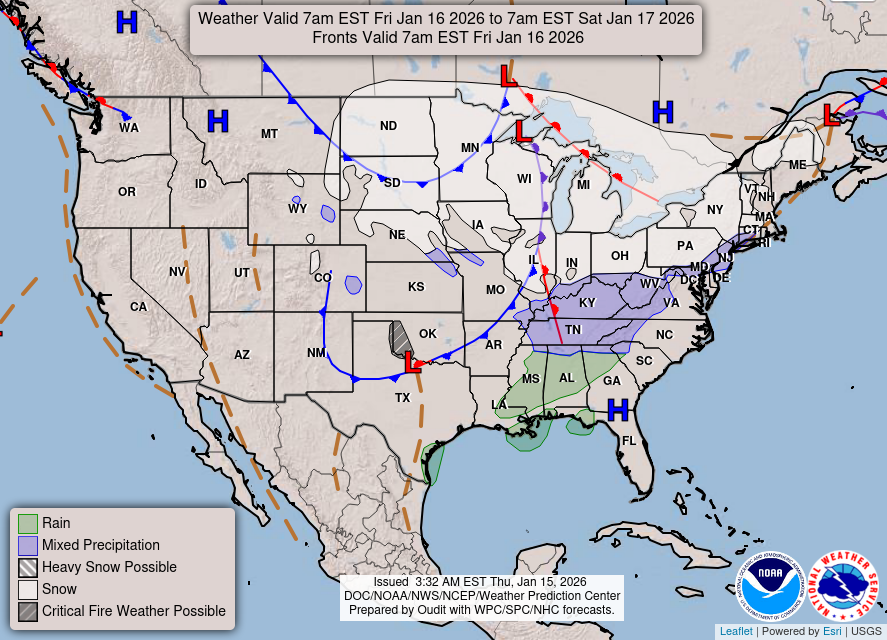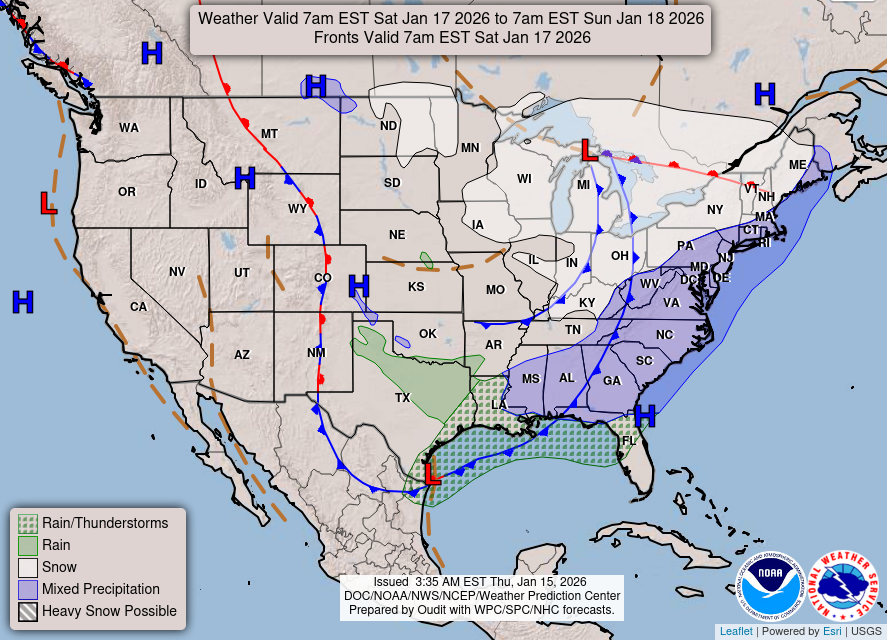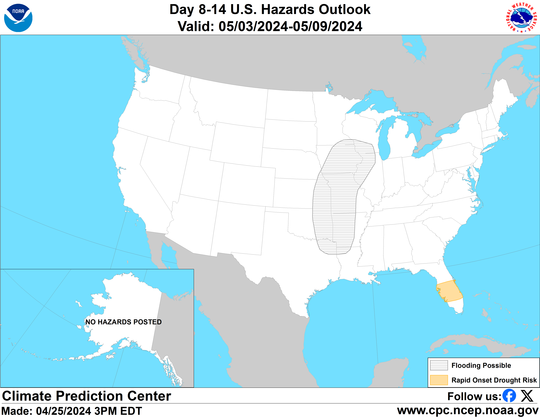This article focuses on what we are paying attention to in the next 48 to 72 hours. The article also includes weather maps for longer-term U.S. outlooks (up to four weeks) and a six-day World weather outlook which can be very useful for travelers.
First the NWS Short Range Forecast. The afternoon NWS text update can be found here after about 4 p.m. New York time but it is unlikely to have changed very much from the morning update. The images in this article automatically update.
Short Range Forecast Discussion
NWS Weather Prediction Center College Park MD
Mon Nov 04 2024
Valid 12Z Mon Nov 04 2024 – 12Z Wed Nov 06 2024…More heavy rain and severe weather focusing across eastern Oklahoma to
the Midwest today will weaken and gradually shift east toward the
Mid-Mississippi Valley on Tuesday……Next round of mountain snow and wind will quickly overspread into the
Pacific Northwest today, across the northern Rockies on Tuesday, and then
into the central Rockies by Tuesday night……Watching South Florida and especially the Florida Keys for impacts
associated with Potential Tropical Cyclone Eighteen which is forecast to
reach hurricane strength by Wednesday morning……Above average temperatures approaching record levels will build across
the Mississippi Valley, Great Lakes, and East Coast…The ongoing active weather system over the south-central U.S. will bring
another day of heavy rain and severe weather across the south-central
U.S., with the heaviest rainfall expected to impact eastern Oklahoma,
northwestern Arkansas, much of Missouri and into Illinois. In addition,
the Storm Prediction Center continues to highlight an Enhanced Risk (level
3/5) of severe thunderstorms centered around eastern Oklahoma and into
adjacent areas where damaging winds, large hail, as well as a few
tornadoes are mostly likely. More energy ejecting from the upper-level
trough currently spreading mountain snow across the Intermountain West
will consolidate a low pressure system over the south-central Plains
today. This system is forecast to push a cold front farther eastward by
tonight, ending the heavy rain threat across Oklahoma but then shifting
the heavy rain and severe weather threats into the Arklatex region,
Mid-Mississippi Valley and across Midwest on Tuesday. As the low pressure
center tracks quickly northeastward across the Great Lakes Tuesday night,
the trailing cold front will weaken with time, leading to a lessening
threat of heavy rain and severe weather farther east across the
Mid-Mississippi Valley on Tuesday. Nevertheless, moderate to locally heavy
rain with embedded thunderstorms are expected to reach into the Ohio and
Tennessee Valleys Tuesday night into Wednesday morning.With another piece of energy associated the upper trough beginning to exit
the Southwest into the Plains today, mountain snow over central Colorado
will slowly taper off while mountain snow over New Mexico will linger into
this evening. A rather strong low pressure system from the Pacific Ocean
will quickly spread the next round of coastal rain into the Pacific
Northwest today followed by a good dose of mountain snow farther inland
along with windy conditions. The mountain snow will then reach into the
northern Rockies Monday night into Tuesday morning as the low pressure
system redevelops over the northern High Plains. The greatest chances
(>80%) for over 8 inches of snowfall in a 24-hour period is forecast over
the northern Cascades on Monday and northern Rockies on Tuesday. Be sure
to prepare for winter driving conditions if traveling throughout these
elevated mountain ranges and stay tuned to the latest local weather
forecast. By Tuesday night into Wednesday morning, the snow is forecast
to blanket the central Rockies into the central High Plains behind a polar
front.Warmer and mostly dry conditions will be felt east of the Mississippi
River through early next week, besides rain chances throughout parts of
the Midwest and Great Lakes. A large high pressure system centered over
the Great Lakes is forecast to slide eastward and off the New England
coastline, ushering in warm southerly flow on the western periphery. This
will support widespread above average high temperatures into the upper 60s
and 70s from the central/southern Plains to the Mid-Atlantic early this
week, with 80s along the Gulf Coast States. When compared to early
November climatology, the Midwest and upper Ohio Valley is expected to
experience temperatures well above average. The anomalous warmth will
eventually spread to the East Coast by Election Day as showers and
thunderstorms ahead of the cold front continue throughout the Midwest and
Mississippi Valley.In the mean time, the National Hurricane Center (NHC) has begun issuing
advisories on Potential Tropical Cyclone Eighteen (PTC 18) in the
southwestern Caribbean. This system has the potential to bring increasing
winds with the arrival of outer rainbands especially for the Florida Keys
by Wednesday morning as the cyclone is forecast to reach hurricane
strength by then. Please refer to the NHC for the latest advisory on PTC
18.
To get your local forecast plus active alerts and warnings click HERE and enter your city, state or zip code.
Learn about wave patterns HERE.
Then, looking at the world and of course, the U.S. shows here also. Today we are looking at precipitation.
Please click on “Read More” below to access the full Daily Report issued today.
| Notices: What would you like to learn about? Please provide that to me via the comment section at the end of the article. |
Now more detail on the 48-Hour Forecast (It is a 48 to 72 Hour Forecast actually)
Daily weather maps. The Day 1 map updates twice a day and the Day 2 and 3 maps update only once a day. These maps update automatically. But if that does not happen, you can get updates by clicking HERE
TODAY (or late in the day the evening/overnight map will appear) (Key to surface fronts shown on maps and you will then also be able to insert a city name or zip code and get a local NWS forecast).

TOMORROW

NEXT DAY

We have a new animation of the forecast which shows how things may play out over the next 60 hours. To update click ANIMATION. Doing so will get you to the dashboard. You can then step through the animation or hit LOOP on the upper right of the display. You will have to hit the back arrow ← at the top left on your computer to get back into this article. It is a little more trouble than before but I think NOAA scrapped the animation routine I was using so we have to keep up with “progress”.
The NWS Climate Prediction Center’s: Watches, Warnings, and Advisories plus other information can be found HERE. That takes you to the NWC Severe Weather Site. From there you can select among many categories of information. Remember to hit the back arrow ← at the top left of your screen to return to this article.
ATMOSPHERIC RIVERS
This tells us what is approaching the West Coast. Click HERE to update If I have not gotten around to doing the update. Here is some useful information about Atmospheric Rivers.

Below is the current five-day cumulative forecast of precipitation (Updates can be found HERE)

Ski SnowReports will Resume in the Fall.
Now we look at Intermediate-Term “Outlook” maps for three time periods. Days 6 – 10, Days 8 – 14, and Weeks 3 and 4. An outlook differs from a forecast based on how NOAA uses these terms in that an “outlook” presents information as deviation from normal and the likelihood of these deviations.
Below are the links to obtain updates and additional information. They are particularly useful if you happen to be reading this article significantly later than when it was published. I always try to provide readers with the source of the information in my articles. These links may also be useful for those viewing this article on a cell phone or other small screen.
| Days 6 – 10 (shown in Row 1) | Days 8 – 14 (Shown in Row 2) | Weeks 3 and 4 (Shown in Row 3 but updates only on Fridays) |
| https://www.cpc.ncep.noaa. gov/products/predictions/610day/ | https://www.cpc.ncep .noaa.gov/products/predictions/814day/ | https://www.cpc.ncep.noaa.gov/products/predictions/WK34/ |
Showing the actual maps. They should now update automatically. The Week 3 – 4 Outlook only updates on Fridays. So below is what I call the Intermediate-term outlook. On Fridays, it extends out 28 Days. That declines day by day so on Thursday it only looks out 22 days until the next day when the Week 3 – 4 Outlook is updated and this extends the outlook by one additional week.
| 6–
10
|
|
|
| 8–
14 |
|
|
| 3–
4 |
|
|
HAZARDS OUTLOOKS
Click here for the latest complete Day 3 -7 Hazards forecast which updates only on weekdays. Once a week probably Monday or Tuesday I will update the images. I provided the link for readers to get daily updates on weekdays. Use your own judgment to decide if you need to update these images. I update almost all the images Friday Night for the weekend edition of this Weather Report. So normally readers do not need to update these images but if the weather is changing quickly you may want to.

Temperature month to date can be found at https://hprcc.unl.edu/products/maps/acis/MonthTDeptUS.png
Precipitation month to date can be found at https://hprcc.unl.edu/products/maps/acis /MonthPNormUS.png
World Forecast [that website is has been intermittent so be patient]
Below are the Day 1 -3 and 4-6 forecasts for temperature and precipitation. Updates and much additional information can be obtained HERE
World Temperature Anomalies


World Accumulated Precipitation


This information is provided by the University of Maine. They draw upon many different sources. There is a lot of information available at the link provided. I have just provided two useful forecasts. There are probably over a hundred different forecasts available from this source.
Worldwide Tropical Forecast (This is a NOAA Product)
This graphic updates on Tuesdays) If it has not been updated, you can get the update by clicking here Readers will only have to do that if they are reading this article much later than the date of it being published.
Information on Tropical Storms can be found HERE. Western Pacific information can be found HERE. Note that unless there is an out-of-season storm the below images will not update until the National Hurricane Center starts their seasonal update of these maps on June 1. I include them simply because there can be an out-of-season event in which case it should show up in these maps.


–
| I hope you found this article interesting and useful. |









